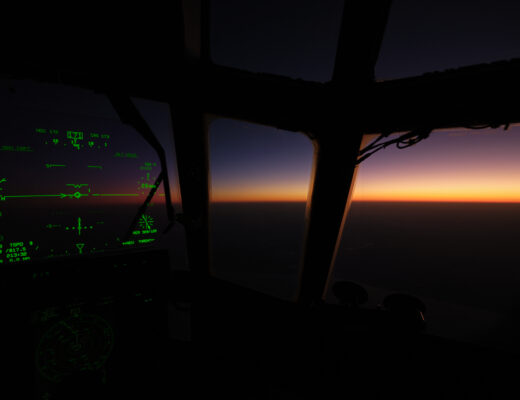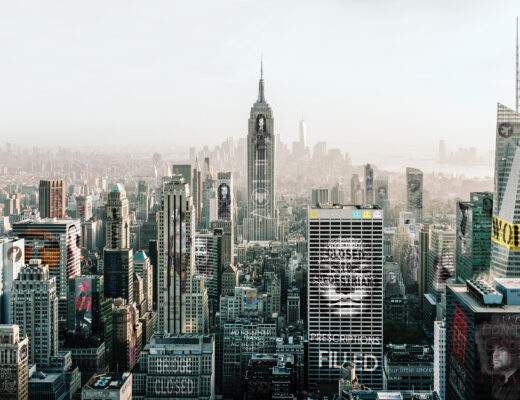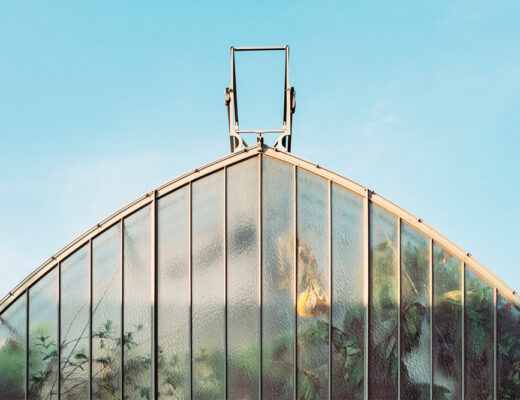You’re on a cruise-liner dialed in at 16 knots maximum speed along a 5-mile journey. Kick back on the observation deck with a beer and pretzel but don’t get too cozy. Your fellow shipmates, gathered starboard, are inching forward in anticipation of a turquoise statue coming clear into view across the New York Harbor. This is the Staten Island Ferry, the canvas of an ongoing photo-project begun over a decade ago.
In early 2018, MTA Arts & Design, a division of the Metropolitan Transportation Authority in New York City, commissioned a series of seven images from my “Ferrying” project for the Bowling Green subway station in Lower Manhattan. Each image was printed on Kodak Duratrans (color transparency) at 66 x 44 inches (198 x 112cm) for installation in seven light boxes. The backlit photos span 40 feet (12 meters) across an orange-tiled wall in the station entrance.
Gear choice is usually an aspect of my photo-making I tend to minimize. Good images can be made with a variety of formats, bodies, and lenses for most applications. However, for my “Ferrying” series, the project flourished over the past five years specifically because of the Fuji mirrorless digital bodies and superb lightweight lenses. While a rival mirrorless system might have yielded similar results, the turning point was the appeal of the Fuji X100S as a second camera (purchased in 2013)—a compact alternative to my traditional Nikon SLR/DSLR system which I’d been invested in for some time and intended to keep for studio work.
It wasn’t the first time a Fuji compact camera was in my bag, or pocket. In 2006, I used the Finepix F30 with its breakthrough CCD sensor for high ISO quality. Handy and impressive for casual use, it wasn’t ideal for the demands of fast-paced street photography. As smart phones emerged and improved, an iPhone camera rarely felt like the tool for me, so I continued trudging along with the DSLR system. The Nikon bodies, (D70, D80, D7000, and eventually the D800) and their loud shutters, combined with the challenge of framing up New Yorkers on high alert, practically had me giving up on street photography. I also shot less on the Staten Island Ferry whose challenges and run-ins with the New York Police Department dated back to 2005 amid the post-911 culture and subsequent infringement on photographer’s rights. Those spurious rules eased up, especially as commuters and tourists eventually toted their own pocketable cameras.
I opted for the X100S because of its quality build, style, and indisputable image quality. Shooting with an APSC sensor was not an issue since I still used the Nikon D800 whose dynamic range was useful in different applications. The X100S put street photography on my map again. And the ferry project found new life. But a full commitment to mirrorless only came when the X-Pro2 was released in 2016. Now in my hands was a modern camera designed to take on the streets with full flexibility. I could shoot covertly, quietly, and strapless; free to wield the slim body with a super-compact 35mm/f2, deftly in hand, either framing through a cutting edge electronic viewfinder or straight from the hip (with a lot of practice). My shooting output increased to the point where I usually have more than a 1000 shots in the image-editing queue at all times.
This style of shooting allows me to blend in more with commuters and tourists on the ferry. There is the occasional posed shot but usually I’m seeking light patterns and how commuters cross into them, or readying for momentary interactions between passengers. Some X-Pro2 shooters appreciate the camera for its classic rangefinder approximation. While I’ve experimented with the optical viewfinder and manual zone focusing, I’ve mainly utilized the X-Pro2’s EVF and range of auto-focus modes. It’s very convenient to tweak the focus point joystick while the camera’s at hip level, rising to the eye in anticipation of what you envision as a photo.
There have been some ergonomic bumps from early on, noted as well by other X-Pro2 users. The ISO dial, requires a lift/turn and often moves the underlying shutter speed dial. The exposure value dial often shifts upon taking it in and out of a bag. In dark conditions, the EVF gain is pumped up so you can see what you’re shooting; metering is effectively disabled but if you’re underexposed the max aperture displays in red. You will see the true exposure only upon playback. The workaround is to keep the lens in manual exposure mode when shooting in the dark.
During the summer of 2016, I shot almost exclusively with the Fuji XF35mm/f2 lens. I briefly tried vintage Nikkors (24 and 50mm Ais) with an adapter; I remained more in tune with the Fuji lenses designed for the body. I added the Fuji 23mm/f2, the 16mm/1.4, and later the 50mm/f2. All perfect for the way I use the X-Pro2.
I trust the image quality of the X-Pro2 even at ISO 6400 when necessary. Shooting night scenes for the ferry project is particularly challenging. Tripods are not allowed and even if they were, the movement of the boat will render camera shake in longer exposures. The X-Pro2 allows for handy and quick adjustments. I’ll sometimes try three exposures with the same framing while quickly moving the joystick to create three separate areas of focus which can be composited in post. I’ve also begun using the double exposure mode—easily executed with a click of the OK button; the resulting initial exposure is seen in the EVF while composing the second image.
Regarding editing workflow, at first, I wasn’t as pleased with the X-Pro2 images as compared to the X100S. There were deeper adjustments to make in Lightroom to get the RAW files looking good. Different sharpening parameters are also necessary. Generally, I use the Classic Chrome camera profile in Lightroom but as of Lightroom 7.3, the new Adobe color camera profiles are much improved. In Lightroom, I’ve created a few custom presets that either incorporate a VSCO preset (Tri-X 400, Provia 400, and Portra 160) or the new Adobe Color or Adobe Vivid profiles and tweak them as needed. I export the adjusted RAW files into Photoshop as a 16-bit 300dpi tif. In Photoshop, I make further adjustments to crop, correct perspective distortion, and spot with the heal tool. These are all possible in Lightroom but I’ve been using Photoshop for more than twenty years and prefer the feel of it.
Working smoothly and discreetly for my “Ferrying” project is largely owed to the design and quality of the X-Pro2. Once the fingers are in tune with the controls it’s easier to forget about mechanics and lock into a creative groove. When shooting action in public, getting into a rhythm and thinking less is essential. The more a camera feels like an extension of the self, comfort and confidence can follow. There’s more room to take risks and make images with minimal constraints.































